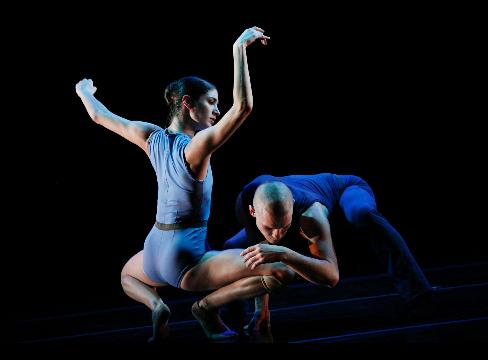This article originally appeared in the Culture section of Bloomberg News on January 24, 2008.

Frances Chiaverini and Matthew Branham perform in “Connoisseurs of Chaos” on Jan 21, 2008. Photographer: Julieta Cervantes/Joyce Theatre via Bloomberg News
Jan. 24 (Bloomberg) — In the hourlong “Connoisseurs of Chaos,” the final installment of choreographer Karole Armitage’s “Dream Trilogy,” six figures twist and angle the postures of classical ballet into a with-it postmodern language.
Set to Morton Feldman’s spare “Patterns in a Chromatic Field,” the piece offers six characters in search of an auteur. Onstage at Manhattan’s Joyce Theater, they are phenomenal bodies that move deftly but lack theatrical personas and the implied emotions, situations or narrative that a top-notch dance maker — even the most abstractly oriented — might provide.
For the most part, these dancers operate as a sextet or in pairs. They perform several extended duets, but never with the same partners. Occasionally a trio or quartet serves as witness or perhaps even sympathizer. The consolation, if indeed it is that, is extended toward a figure abandoned after one of the long duets. You might, in a desperate effort to remain awake and attentive, read this as wisps of tenderness stamped out by a pervading hostility between the sexes.
The piece superficially displays a preoccupation with George Balanchine’s “Agon” and “Episodes,” even to the belted leotards Peter Speliopoulos has given the dancers. Yet it lacks the very basic qualities, beginning with incisive structure, that distinguish those works of genius. Armitage, both onstage and off, maintains the attitude that she’s doing something new. I suspect she thinks she’s going beyond Balanchine.
Forbidding Trees
David Salle, a longtime Armitage contributor and intimate, provides a black-and-white film projection on the backdrop throughout the middle of the piece that gives the dance what little context it possesses. In one lovely passage, the camera gazes through a window at a snow-strewn stand of forbidding black-branched trees. Eerily, on the indoor side of the framed glass, translucent curtains are blown by a breeze that has no logical wind behind it.
Slowly, the camera zeros in on the scene, which then suddenly dissolves into a violent vortex. That trick is trite, but at one point the camera loses the window frame and curtain (elements connoting theater) and just shows the desolate frosty landscape. Armitage has her dancers lie down before it in near- darkness as if it were the landscape of their inner being.
The Feldman score, played live by Felix Fan (cello) and Andrew Russo (piano) was compelling, but it isn’t helpful as dance music and Armitage isn’t notably musical.
At the Joyce Theater, 175 Eighth Ave. at 19th Street, through Jan. 27. Information: +1-212-242-0800; http://www.joyce.org.
Bigonzetti’s `Oltremare’
The Italian choreographer Mauro Bigonzetti, whose “Oltremare” (Beyond the Sea) had its world premiere last night, seems to be an affable artist, willing to try anything once. This is the third work Bigonzetti, who heads Aterballetto, based in Reggio Emilia, has made under commission for the New York City Ballet.
The first, the antic “Vespro” (2002), was memorable mainly for having the usually inexpressive Benjamin Millepied cavorting atop a grand piano. “In Vento” (2006) was graver, with darkly lush inventions for its small ensemble and an incomprehensible relationship among its principals.
“Oltremare” depicts a small crowd of working-class people, about to abandon the Old World for the New. To a spare, folk- tinged score by Bruno Moretti, the choreographer’s frequent collaborator, they mime grief and apprehension, along with the steadfast determination such a displacement requires. Still, the emotions come across as cliches, and the yesteryear look of the dancers’ costumes is absurdly at odds with their acrobatic dancing.
The cast did its best — Maria Kowroski and Georgina Pazcoguin were particularly effective — but classical dancers are the wrong breed for the subject and Bigonzetti is the wrong choreographer. Spend a day at the heart-wrenching Ellis Island Immigration Museum and you will know why.
The New York City Ballet is at the New York State Theater, Lincoln Center, through Feb. 24. Information: +1-212-721-6500 or http://www.nycballet.com.
© 2008 Bloomberg L.P. All rights reserved. Reprinted with permission.



